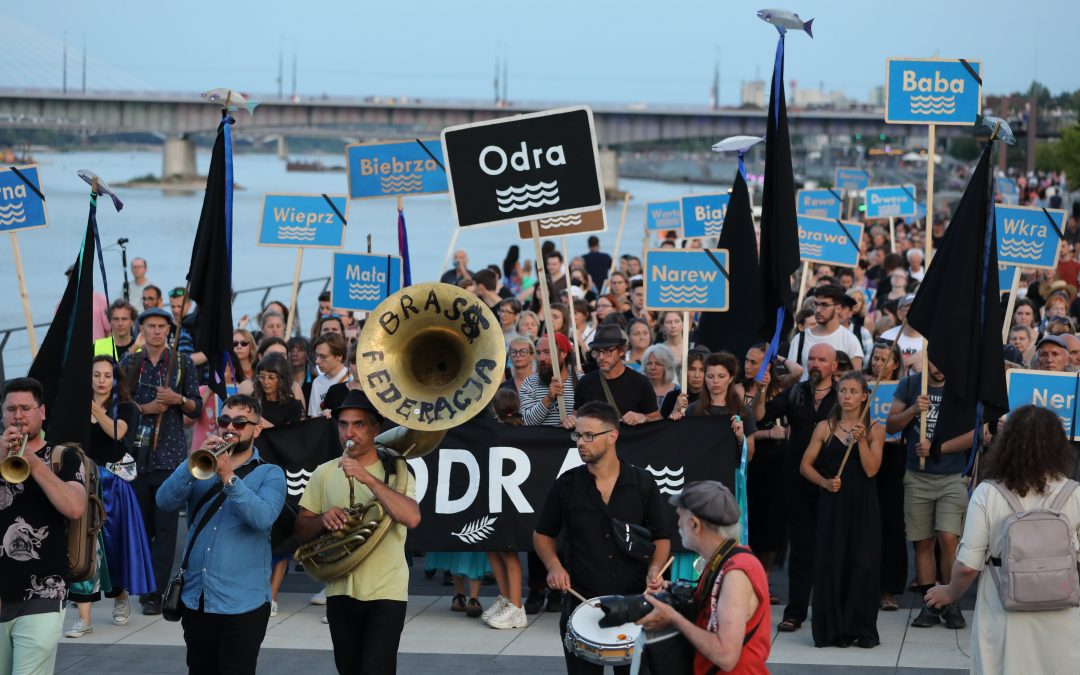“Marches of mourning” have been held in the Polish cities of Warsaw, Wrocław and Łódź amid the poisoning of Oder river, where over 100 tonnes of dead fish have washed up for reasons that are still not fully clear.
Meanwhile, a group of anglers in one region along the river have mobilised to save fish by transferring them to a reservoir with cleaner water.
In Warsaw, several hundred people gathered on Sunday on the boulevards of the Vistula, another Polish river, with many dressed in black. The protest remained quiet and sombre, as organisers had requested, with participants holding up the names of Polish rivers and black ribbons.
Daniel Petrykiewicz, an activist who took part, told Gazeta Wyborcza that the issue was not just what is currently happening in the Oder, but rather “years of neglect” of the environment in Poland. “That’s why we’re walking in a silent march, not demanding that specific people be fired.”
In Wrocław, where several dozen people gathered, the protesters were more vocal about their demands. They called for statutory changes to safeguard the environment and demanded that Prime Minister Mateusz Morawiecki take political responsibility for the disaster by resigning.
“The authorities have failed us. This is not just an environmental disaster, it is a disaster of the Polish state,” said Krzysztof Smolnicki, from the regional branch of Smog Alarm, a group that seeks to tackle air pollution, quoted by Gazeta Wyborcza.
Meanwhile, a group of anglers in the West Pomeranian province, through which the Oder runs, have taken action by using nets to catch carp, amur and catfish from the river and transfer them to pools in which a pump is being used to oxygenate the water, reports Wirtualna Polska.
“The first fish we caught have been in the pools for almost a week,” said one of the anglers involved. “For example, a 20-kilogram carp, which was remaining still, waiting for its end, did not struggle when being caught. Now it has already gained vigour [so] that it can’t be held. So it is not that poisoned fish are unsalvageable.”
“At first there were a few of us and we were not sure if it made sense,” he added. “Now there are 30 of us, we are supported and advised by a carp farmer, and there are four ichthyologists among us…The idea is to save the biggest [fish], especially the females, which are important for the reproduction of the population.”
Once the poisoning of the Oder passes, the fish will be returned to the river. Tags have been attached to their fins to identify them as “the survivors of the Oder disaster”.
Gdy nadchodziła fala zatrutej wody, nie chcieli czekać z założonymi rękami na katastrofę. Stworzyli swoją "Arkę Noego" dla zagrożonych gatunków.https://t.co/K5XILqPPi7
— Wirtualna Polska (@wirtualnapolska) August 20, 2022
In recent weeks, scientists and officials in both Poland and Germany – along whose border the river runs – have been trying to figure out what has caused the mass deaths of fish in the Oder.
Last week, the Polish climate ministry reported that toxic golden algae could be the culprit. An additional element contributing to fish extinction is very low oxygen levels in water overflowing with dead fish.
At the weekend, the Polish climate minister accused German media of spreading fake news, after a newspaper reported that extremely high concentrations of pesticides were found in water samples from earlier this month, something that Poland denies.
The German government is "surprised and saddened" by Warsaw's suggestion that Germany has been spreading "fake news" about the poisoning of the Oder river, says a spokesman https://t.co/h5Utv01C81
— Notes from Poland 🇵🇱 (@notesfrompoland) August 22, 2022
Main photo credit: Slawomir Kaminski / Agencja Wyborcza.pl

Alicja Ptak is deputy editor-in-chief of Notes from Poland and a multimedia journalist. She has written for Clean Energy Wire and The Times, and she hosts her own podcast, The Warsaw Wire, on Poland’s economy and energy sector. She previously worked for Reuters.




















